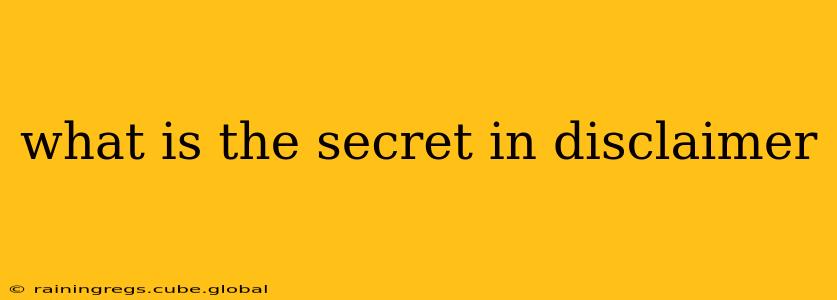The Secret in a Disclaimer: Protecting Yourself and Managing Expectations
Disclaimers might seem like boring legal jargon, but they're actually a powerful tool for protecting yourself and setting clear expectations with your audience. The "secret" isn't a hidden code, but rather a strategic understanding of their purpose and how to write effective ones. This goes beyond simply slapping a generic statement at the bottom of a page; it's about crafting clear, concise language that safeguards your interests while maintaining transparency and trust.
This article will explore the true power of disclaimers, uncovering the key elements that make them effective and answering some frequently asked questions.
What is the Purpose of a Disclaimer?
The primary purpose of a disclaimer is to limit liability and manage expectations. It acts as a shield against potential legal challenges and misunderstandings. By clearly stating what you are and are not responsible for, you protect yourself from claims of negligence, misinformation, or breach of contract. This is crucial across various applications, from websites and social media to product descriptions and marketing materials.
What are the Key Components of an Effective Disclaimer?
A well-crafted disclaimer includes these crucial components:
-
Specificity: Avoid vague language. Clearly define the specific limitations of your liability or the scope of your claims. Instead of "We are not responsible for any errors," try "We strive for accuracy, but we are not liable for any errors or omissions in this information."
-
Clarity and Conciseness: Use plain language that is easily understandable to your target audience. Avoid legal jargon that may confuse or alienate readers.
-
Prominent Placement: Make sure your disclaimer is easily visible and accessible. Don't bury it in fine print at the bottom of a page. For websites, consider placing it in the footer or a dedicated legal page, clearly linked from other pages.
-
Regular Review: Laws and regulations evolve. Regularly review and update your disclaimers to ensure they reflect current legal requirements and accurately reflect your practices.
What are Different Types of Disclaimers?
Different contexts require different types of disclaimers:
-
Website Disclaimers: These cover website content accuracy, liability for links to external sites, and user-generated content.
-
Product Disclaimers: These detail limitations of warranties, potential risks associated with using the product, and any safety precautions.
-
Medical/Health Disclaimers: These emphasize that information is not a substitute for professional medical advice and should not be used for self-diagnosis or treatment.
-
Affiliate Marketing Disclaimers: These disclose any affiliations or commissions earned from promoting products or services.
-
Copyright Disclaimers: These protect the intellectual property rights of the content creator.
What Information Should I Include in My Disclaimer?
The specific information included depends on your context. However, common elements include:
-
Limitations of Liability: Clearly state the extent to which you are not responsible for damages, losses, or injuries resulting from the use of your product, service, or information.
-
No Warranty: Specify that there is no implied or express warranty of any kind.
-
Accuracy of Information: State that you make every effort to ensure accuracy but do not guarantee it.
-
External Links: If linking to external websites, state that you are not responsible for the content or accuracy of those sites.
How Can I Make My Disclaimer More Legally Sound?
While this article provides general guidance, it's crucial to consult with legal counsel to ensure your disclaimer is legally compliant with applicable laws and regulations in your jurisdiction. A lawyer specializing in intellectual property or contract law can help you craft a disclaimer that effectively protects your interests.
Is a Disclaimer Enough to Protect Me from All Liability?
No. A disclaimer is a significant step toward protecting yourself, but it's not a foolproof guarantee against all liability. Ethical practices, accurate information, and compliance with all relevant laws and regulations remain paramount. A disclaimer is part of a broader strategy for risk management.
In conclusion, the "secret" to a successful disclaimer is a proactive and informed approach. It's not about hiding behind legalese, but about transparently setting expectations and protecting yourself within the boundaries of the law. Remember to consult with legal professionals to ensure your disclaimer is tailored to your specific needs and complies with all relevant regulations.
